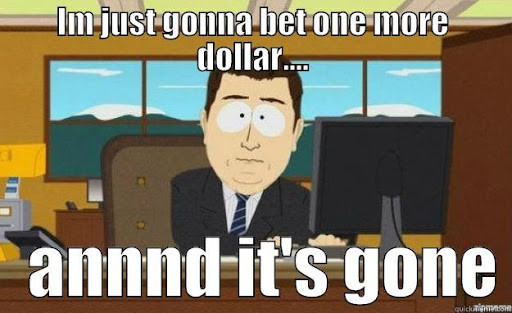
Anyone with a love of roulette has surely heard of the Martingale system. There is a certain logic and structure behind why it ‘can’ work to your benefit, but it’s a system that is very unforgiving should you find yourself on a losing streak. The principle behind it is very straightforward; betting on red or black you simply double down every time you lose, until your number comes up. It goes like this:
- You bet $10 and lose (bankroll at -10).
- You bet $20 and lose (bankroll at -30).
- You bet $40 and lose (bankroll at -70).
- You bet $80 and lose (bankroll at -150).
- You bet $320 and win (bankroll at +10).
This clearly illustrated both the reasoning behind it as well as its fatal flaw. When the going is good you can add to your winnings over time in a very consistent way. However, roulette has some improbably runs of a single colour for instance, and if you find yourself caught in the midst of one of those, you’ll soon be gambling mind boggling amounts in order to simply claw your money back. There are no shortage of horror stories of those pushing things too far with the Martingale system and losing everything. It ‘feels’ like a foolproof system until it suddenly goes off the rails.
Notable individuals with connections to the Martingale system include the likes of David Cloe, an artist who made his millions ($200 million to be precise) via cashing in shares he has given upon completing a Mural in the early days of Facebook. He’s said to have gone from $500 t $1 million on one casino trip. Though to eventually jacked in the gambling on account of suffering an angina attack at just 35 due to his hedonistic party lifestyle.
Another Martingale madman is Charles Wells, the nineteenth century conman who conned people out of £4000 (worth £130,000 today) before gambling with it Monte Carlo. He experienced the run of a lifetime breaking the bank on multiple occasions to the tune of a million francs total (£4 million total). He later returned and repeated the feat! In interviews he proclaimed that he used a secret strategy, only for it later to emerge that he simply used the Martingale system. It proved to be his undoing on his fateful third trip to Monte Carlo. He lost everything and to top it off was arrested for fraud upon his return to Britain.
Distributed by Universal Pictures in 2005, Two for the Money is a sports drama film starring Al Pacino, Matthew McConaughey and Rene Russo. Brandon Lang (McConaughey) is a former college football star who, after suffering a career-ending knee injury, is reduced to a telemarketing role, predicting football results on behalf of gamblers. Nevertheless, the remarkable accuracy of his predictions attracts the attention of Walter Abrams (Pacino), head of a thriving sports trading websites with its own cable television show called ‘The Sports Advisors’.
Abrams recruits Lang, who moves from Las Vegas to Manhattan, where his whole image is overhauled to create an entirely fictitious, but nonetheless slick, persona, by the name of ‘John Anthony’. Lang, as John Anthony, is added to the roster of regular pundits on ‘The Sports Advisors’, much to the annoyance of previous ‘blue-eyed boy’ Jerry Sykes (Jeremy Piven), and proves an immediate success.
However, seduced by the trappings of his newly-found high-rolling lifestyle, Lang becomes complacent in his work, relying on hunches rather than his knowledge of the game, with predictably disastrous results. At one point, he is physically assaulted by associates of a disgruntled client. Abrams, a recovering, but by no means recovered, alcoholic and gambling addict, soon turns on his protégé and even suspects that Lang is having an affair with his doting wife, Toni (Russo). The relationship between the two men disintegrates, irrevocably, as they try to outsmart each other. Lang does make two successful predictions for the Super Bowl, both made tossing a coin, but leaves Abrams to pursue a less glamorous career, coaching junior league tackle football.
A fascinating and enthusiastic look at some of the top poker chips from 2018.


